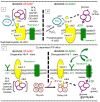The Effect of Sepsis on the Erythrocyte
- PMID: 28885563
- PMCID: PMC5618581
- DOI: 10.3390/ijms18091932
The Effect of Sepsis on the Erythrocyte
Abstract
Sepsis induces a wide range of effects on the red blood cell (RBC). Some of the effects including altered metabolism and decreased 2,3-bisphosphoglycerate are preventable with appropriate treatment, whereas others, including decreased erythrocyte deformability and redistribution of membrane phospholipids, appear to be permanent, and factors in RBC clearance. Here, we review the effects of sepsis on the erythrocyte, including changes in RBC volume, metabolism and hemoglobin's affinity for oxygen, morphology, RBC deformability (an early indicator of sepsis), antioxidant status, intracellular Ca2+ homeostasis, membrane proteins, membrane phospholipid redistribution, clearance and RBC O₂-dependent adenosine triphosphate efflux (an RBC hypoxia signaling mechanism involved in microvascular autoregulation). We also consider the causes of these effects by host mediated oxidant stress and bacterial virulence factors. Additionally, we consider the altered erythrocyte microenvironment due to sepsis induced microvascular dysregulation and speculate on the possible effects of RBC autoxidation. In future, a better understanding of the mechanisms involved in sepsis induced erythrocyte pathophysiology and clearance may guide improved sepsis treatments. Evidence that small molecule antioxidants protect the erythrocyte from loss of deformability, and more importantly improve septic patient outcome suggest further research in this area is warranted. While not generally considered a critical factor in sepsis, erythrocytes (and especially a smaller subpopulation) appear to be highly susceptible to sepsis induced injury, provide an early warning signal of sepsis and are a factor in the microvascular dysfunction that has been associated with organ dysfunction.
Keywords: erythrocyte; morphology and microcirculation; rheology; sepsis.
Conflict of interest statement
The authors declare no conflict of interest.
Figures




References
-
- Singer M., Deutschman C.S., Seymour C.W., Shankar-Hari M., Annane D., Bauer M., Bellomo R., Bernard G.R., Chiche J.D., Coopersmith C.M., et al. The third international consensus definitions for sepsis and septic shock (sepsis-3) JAMA. 2016;315:801–810. doi: 10.1001/jama.2016.0287. - DOI - PMC - PubMed
-
- Bateman R.M., Jagger J.E., Sharpe M.D., Ellsworth M.L., Mehta S., Ellis C.G. Erythrocyte deformability is a nitric oxide-mediated factor in decreased capillary density during sepsis. Am. J. Physiol. Heart Circ. Physiol. 2001;280:H2848–H2856. - PubMed
Publication types
MeSH terms
Substances
LinkOut - more resources
Full Text Sources
Other Literature Sources
Medical
Miscellaneous

